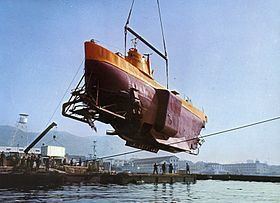 | ||
Similar Ben Franklin (PX 15), FNRS 3, FNRS 2 | ||
The bathyscaphe Archimède is a deep diving research submersible of the French Navy. It used 42,000 US gallons (160,000 l) of hexane as the gasoline buoyancy of its float. It was designed by Pierre Willm and Georges Houot. Archimede was the first vehicle to reach the deepest part of the Atlantic, 27,510 feet (8,390 m) down into the Puerto Rico Trench.
Archimede was christened on 27 July 1961, at the French Navy base of Toulon. It was designed to go beyond 30,000 yards (27,000 m), and weighed 61 tons.
In October 1961, Archimede passed its first dive tests, diving to 5,000 feet (1,500 m) unmanned.
On 27 November 1961, Archimede achieved a speed of 3knots, over a distance of 4.5 miles (7.2 km) at a depth of 7,870 feet (2,400 m) in the Mediterranean.
On 23 May 1962, Archimede descended to 15,744 feet (4,799 m) off Honshu, Japan, in the Pacific, at the Japan Deep.
On 15 July 1962, Archimede descended to 31,350 feet (9,560 m) into the Kurile-Kamchatcha Trench, making it the second deepest dive ever, at that point in time, second only to the Bathyscaphe Trieste dive on the Challenger Deep.
On 12 August 1962, Archimede descended to 30,511 feet (9,300 m) in the Japan Deep south of Tokyo.
Archimede explored the Mid-Atlantic Ridge jointly with the submarine Cyana and submersible DSV Alvin, in Project F.A.M.O.U.S.(French American Mid Ocean Underwater Survey) in 1974.
Archimede operated until the 1970s. As of 2008, it is on operational reserve, at Toulon.
The Archimede was honoured with a stamp in Palau.
